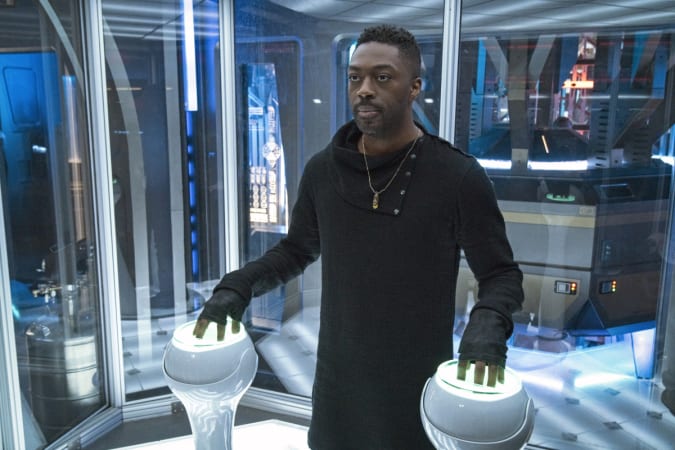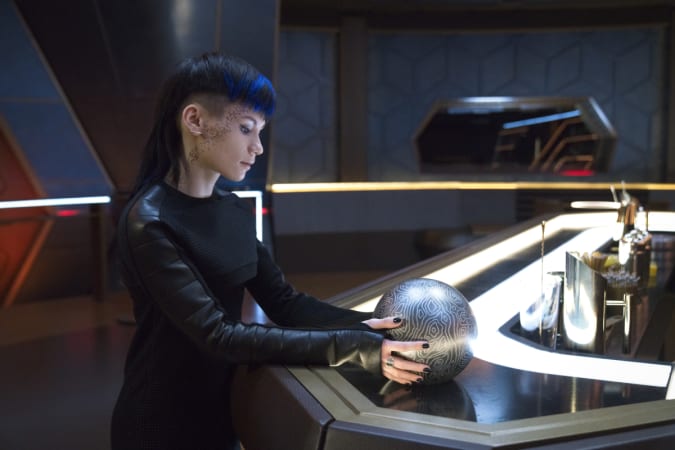‘Star Trek: Discovery’ finally embraces standalone storytelling in its fourth season
The following contains minor spoilers for season four, episode six of ‘Star Trek: Discovery‘ (and vague discussion of episode seven).
There’s a bit of a trend or tradition among Star Trek shows, starting with The Next Generation. Somewhere around season three or four the show finds its way and actually becomes good, if not great. This isn’t a phenomenon limited to Trek, of course, but only Trek has a specific name for it: growing the beard. This is in reference to commanders William Riker and Benjamin Sisko, who both started their respective shows clean-shaven but grew beards around the time The Next Generation and Deep Space Nine got noticeably better. And Discovery might finally be ready to do its own metamorphosis, but instead of a beard it’s a change of format that has fans talking.
One of the complaints about Discovery’s first three seasons — besides the grimdark tone, the infallibility of Michael Burnham and all the crying — was that it largely embraced a more serial format, where each episode was another installment in one long ongoing storyline. Sure, there were occasional one-off adventures, but each episode was still firmly focused on the larger story.
CBS
Season four started off in the same manner, with the season premiere and second episode dedicated to setting up the new status quo of rebuilding the United Federation of Planets and introducing this season’s big threat: the Dark Matter Anomaly (DMA). However, unlike previous seasons where each episode would have been focused on one step toward finding a solution, the problem-solving has taken a back seat to a largely standalone A-plot.
The shift could be first seen in episode three, where Burnham and her crew are tasked with tracking down a rogue member of the Qowat Milat (as I described them to my editor: ninja nuns). The DMA is more of a C-plot in this episode, with the B-plot position occupied by the story of Gray Tal and his new android body. Episode four was Tilly trying to train and keep a group of Starfleet cadets alive (in a plot reminiscent of Voyager episodes ‘Learning Curve’ and ‘Good Shepherd’). Episode five saw the crew tasked with evacuating a planet threatened by the DMA. The anomaly may have been the instigating force in the episode, but it was in fact interchangeable with pretty much any other planetary threat since the episode was focused more on Michael’s struggle to free six prisoners on the surface.

CBS
This week’s episode finds Discovery traveling into a subspace rift created by the DMA and becoming stranded, with the ship’s newly sentient AI Zora unable to lead the crew to safety. However, while the anomaly is once again the cause of Discovery’s problems it’s also, once again, an interchangeable threat. The real drive of the episode is the problem-solving to get the crew out, and the personal struggles of characters like Zora and Cleveland Booker.
Next week will bring the Dark Matter Anomaly back to the forefront, but that’s only logical since the seventh episode marks the rough midpoint of the 13-episode season as well as the end of our calendar year. It’s not unusual for many television shows to use this time to “check in” on their major storylines and advance those plots to the next phase. But it is unusual for Discovery in that it doesn’t represent as clean a divide as in previous seasons: season one went from the Klingon War to the Mirror Universe, season two went from the mystery of the Red Angel to battling the evil AI Control. Next week’s episode represents a smoother transition than previously.

CBS
That smoothness is mostly due to the fact that the ongoing storyline hasn’t been given as much time to openly flourish, instead bubbling in the background while the show instead focuses on character-building single-shot adventures. Standalone episodes might feel outdated in an era of streaming and binging, where viewers can get their answers right away so there’s no need to make each individual chapter feel “complete.” There’s no chance to become unsatisfied by the content of an episode when the next one is merely seconds away. Even shows that premiere week by week have fallen into the trap, assuming that most viewers will binge the show later on anyway, with only the diehards watching each installment as it drops.
But for most of its existence at this point, Star Trek has been a franchise for the die-hards. The people who can’t wait for the next episode, the people who will read and write recaps on their favorite pop culture sites and those who share theories on social media. Paramount+ has put a lot of its chips on the strength of this die-hard base, stacking its production schedule with five different Star Trek shows that rarely overlap, meaning a fan who wants to see everything as soon as possible will need to maintain their Paramount+ subscription all-year-round.

CBS
While fan complaints may have played a big role in Discovery’s decision to switch to a more episodic format, it’s likely that the desire to keep fans on the hook for the show’s entire run played an even bigger part. When Discovery was the only Star Trek show, and one of the few Paramount+ offerings period, it was common for viewers to only sign up for a subscription when they wanted to binge something — sometimes even within the free week the service offers to new customers. Shows like Lower Decks, Prodigy and the upcoming Strange New Worlds already operate with a more episodic format, meaning Discovery could have created a “hole” in an ongoing subscription for viewers, a chance for them to take a break from Star Trek and from paying $6 a month.
With an episodic show it’s a lot harder to ignore it while it’s running; each episode represents a complete viewing experience, making the wait between episodes less excruciating. And when Discovery encounters new worlds and new adventures every week, it gives the fans something new to talk about, instead of rehashing the same old theories about the ongoing storyline again and again until the season ends. Star Trek was just made for episodic viewing, and embracing the format will make it easier for Discovery to hold fan interest over time.
All products recommended by Engadget are selected by our editorial team, independent of our parent company. Some of our stories include affiliate links. If you buy something through one of these links, we may earn an affiliate commission.
For all the latest Technology News Click Here
For the latest news and updates, follow us on Google News.
